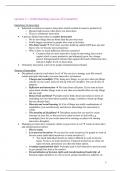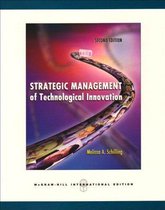Lecture 1 – Understanding sources of innovation
Importance of innovation
• Industrial revolution is massive innovation which resulted in massive productivity
o Became high income when there was innovation
o There is continuous innovation
• A process behind innovation is creative destruction
o We do new things that are better than the previous ones
o Profits trigger reactions by people who want to do better
o The Solow model → Over time, societies build up capital (GDP goes up) and
that is why we become more prosperous
o Why is there so much difference between countries?
▪ Countries that are more innovative, keep on innovating, have newer
capital which is more productive and ultimately grow for a longer
period. Entrepreneurial climates that support this kind of behaviour also
end up in higher levels of innovation.
• Ultimately innovation is driven by people (entrepreneurial climate)
Sources of innovation
• Disciplined creativity (individual level) → You can try to arrange your life around
certain principles that make you more innovative in business
o Change and serendipity → By doing new things, we get new ideas (do things
outside of your scope, and you end up with new insights). You can do this on
purpose.
o Reflection and interaction → We learn from reflection. If you want to learn
more about whether things work or not, then you should reflect on why things
did not work.
o Bend, break and blend → people tend to think about innovation in terms of
something new but innovations actually change, combine or break up things
that are already there.
o Diversity and social learning → A lot of things are subtle combinations of
capabilities (you need diversity and diverse knowledge for innovation to
work).
o The meaning of disciplined → Discipline means that you need to create
structure in your life, so that you have a plan on how to deal with e.g.
serendipity (how do you create innovative meetings or places for sharing
innovative thoughts).
• Managing an innovative corporate culture (organization level) → create an innovative
and entrepreneurial culture
o Diverse teams
o Low powered incentives → you need to create incentives for people to work in
diverse teams (individual incentives or team incentives?).
▪ Too much individual incentives make it difficult to work in diverse
teams. Focus is on team incentives. Financial incentives are often not
super relevant, promotions are often the better option.
o Creating organizational slack → people need to feel themselves and you need
to give people free time to be creative
o Decentralization of decision rights and transformational leadership →
Decision rights should be on a lower level, people should have authority on
1
, lower levels. Reporting on what you are doing in decentralized firms is much
easier which leads to more decision rights in lower levels, which leads to more
innovation. Instead of controlling people, you need to transform the way
people think about processes (transformational leadership). You give them
new big ideas without controlling them.
• Orchestrating innovation: The industry level
o Managing open innovation →
o Creating an innovation ecosystem → Create an ecosystem of companies with
different functionalities to collaborate where you create different value
propositions to create a joint VP.
o Connecting fundamental and applied research → how do you shape
fundamental research agendas to create higher chances of commercial
application?
o Mapping societal trends through Non-Governmental Organizations → Shape
customers opinion leading to success in the market
Innovation challenges
1. Funding innovation in a globally competitive environment
o The challenge is; how do you fund things that are profitable in 10 years from
now?
o For things that really matter, you need to have money to wait 10 years
o You need to look for things
that happen 10 years from
now (entrepreneurial
mindset).
o S-shaped technology trends
→ black one is how revenue
is shaped over time (first no
customers, then rapid increase
and then destruction),
technology development is
the curve on the cost part for
development of the
technology, technology
adoption is also a cost curve
about the costs of people to
adopt it
2. Skill biased technological change, job market polarization and the rise of inequality
o Everything we teach should be different than machines
o Rising income inequality → quick rise in the share that is earned by the top 1%
which creates massive inequality (very few benefit from innovation)
o Job market polarization → you work in high paying jobs or low paying jobs,
but middle/moderate level jobs disappear.
3. Getting political institutions right
o Only very few people are engaged in innovative activities
o There is a background of people with facto political power (Poetin, Erdogan
etc.) → make sure the political system is rigged
2
,Book Chapter 2 – Industry dynamics of technological innovation:
Innovation can arise from many different sources such as individuals, universities,
governments and non-profit organizations. Firms are one primary engine of innovation as they
have great resources and strong incentives to differentiate. Networks of innovators are an
even more important source of innovation as they leverage knowledge and other resources.
Any innovation may emerge primarily from one or more components of the system or
linkages between them.
Innovation begins with the generation of new ideas. The ability to generate new and useful
ideas is called creativity. Novel work must be different from work that has been previously
produced. A reinvention is a product that is novel to someone who made it, but known to most
everyone else. The creative ability is formed by:
• Intellectual abilities; intelligence, memory and ability to look at problems in a
different way. Primary process thinking is also important which is the ability to let a
mind engage in visual mental activity which leads to divergent thinking.
• Knowledge; this should be balances as too much knowledge can make a person
trapped in logic, preventing the person to come up with alternative perspectives. Lots
of ideas often come from outsiders as they have different perspectives on problems as
they are not trapped by paradigms and assumptions.
• Personality; Openness to experience is important for intellectual curiosity
• Motivation; if you are interested in something, there is more creativity where extrinsic
motivations can undermine creativity.
• Environment; Support of the environment is needed with time to explore ideas
The individuals, structure, routine and incentives of a firm determine its overall creativity
level. Companies often tap the creativity of its individual employees. Creativity training
programs at firms are often more effective than monetary awards as it signals employees that
their thinking and autonomy are respected.
Innovation is more than the generation of creative ideas, it is the implementation of those
ideas into some new device or process. It requires combining a creative idea with resources
and expertise that make it possible to embody the creative idea in a useful form. Innovation
often originates with individual inventors that have different perspectives on things, are
curious, question assumptions and think that all knowledge is unified.
Innovation often originates from those who create solutions for their own needs, not co
commercialize or patent their work (user innovators). Another source of innovation is a firm’s
own R&D. Research refers to basic research and applied research:
• Basic research is effort directed at increasing understanding of a topic without
immediate commercialization in mind
• Applied research is directed at increasing understanding of a topic to meet a specific
need.
Development refers to activities to apply knowledge to produce useful devices, materials or
processes. Most countries spend more on applied research and experimental development than
basic research.
The science-push approach to R&D assumed that innovation proceeded linearly from
scientific discovery, to invention, to engineering then manufacturing and finally marketing.
3
, This, however, has little applicability. The demand-pull model argues that innovation is driven
by demand where new products are developed to respond to customer problems. Firms are
successful innovators when they utilize multiple sources of information:
• In-house R&D, including basic research
• Linkages to customers
• Linkages to an external network of firms (customers, suppliers, competitors and
complementors); used to exchange information and other resources. Users are often
the most valuable source of new ideas. Complementors are organizations that produce
complementary goods. Some firms are both complementors as competitors. External
sources of information are more likely to be complements than substitutes for in-house
R&D. Doing in-house R&D helps build a firm’s absorptive capacity, enabling it to
better assimilate and utilize information obtained externally.
• Linkages to external sources of scientific and technical information; research from
public and nonprofit institutions help develop innovations. To increase the degree to
which university research leads to commercial innovation, many universities have
technology transfer offices. Governments also invest in research through labs, the
formation of science parks and incubators and grants for other public/private entities.
Private nonprofit organizations also contribute to innovation. They perform their own
R&D, fund R&D of other organizations, or do both.
Collaborative research is especially important in high-technology sectors where one single
firm is unlikely to have all resources and capabilities. These networks of collaboration can
enable firms to achieve much more than individually. Technology clusters are regional
clusters of firms that have a connection to a common technology, and may engage in buyer,
supplier and complementor relationships as well as research collaboration. Regional clusters
are better for knowledge transfer (e.g. Silicon Valley). Proximity ad interaction can influence
a firm’s ability to exchange knowledge:
• Knowledge that is complex or tacit may require frequent and close interaction
• Closeness and frequency of interaction can influence the willingness to exchange
knowledge. Frequent interaction can foster trust.
A cluster of firms with high innovation productivity can lead to more new firms starting up
which can attract other firms to the area. The benefits firms reap by locating in close
geographical proximity to each other are known as agglomeration economies. However there
are downsides:
• Increased competition in local markets
• Increased likelihood of competitors gaining access to a firm’s proprietary knowledge
• Can lead to traffic congestion, high housing costs and higher concentrations of
pollution (as more firms enter the area)
The degree to which innovative activities are geographically clustered depend on:
• The nature of the technology, e.g. underlying knowledge or the degree to with it can
be patented
• Industry characteristics, e.g. market concentration, transport costs and availability of
suppliers
• The cultural context of the technology, e.g. population density of labor or customers,
national differences in the way technology development is funded
The spread of knowledge across organizational or regional boundaries is called technological
spillovers which occur when the benefits from the research activities of one firm spill over to
4





